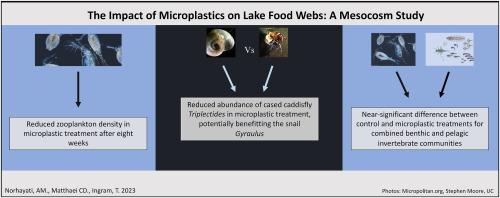微塑料对湖泊群落的影响:中观宇宙研究
IF 8.1
2区 环境科学与生态学
Q1 ENVIRONMENTAL SCIENCES
引用次数: 0
摘要
塑料是一种普遍存在的污染物,为了满足消费者的需求,其生产速度越来越快。塑料进入环境后会分解,产生更小的碎片,包括二次微塑料。世界各地都有湖泊受到微塑料污染的记录,浮游动物、大型无脊椎动物和鱼类也有摄入微塑料的记录。微塑料的摄入和暴露会对这些生物群体造成不同程度的有害影响,但现实中微塑料浓度对整个淡水食物网的影响还需要进一步研究。为了填补这些知识空白,我们在 1200 升室外中置池中进行了为期 8 周的实验,将微塑料添加浓度为 1.5 微粒/升与鱼类捕食者(鲈鱼)的存在进行因子交叉。微塑料暴露对浮游动物丰度的影响随时间而变化,实验结束时,塑料处理的浮游动物丰度较低。虽然微塑料对大型无脊椎动物的总丰度没有影响,但对个别类群有影响。在有微塑料存在的情况下,有壳笛鲷的丰度明显降低,这可能导致第 8 周蜗牛的丰度增加。在底栖和浮游无脊椎动物群落中,对照组和塑料处理组之间的成分差异接近显著。这些研究结果表明,接触微塑料可能会对淡水无脊椎动物群落产生负面影响,即使是在代表目前湖泊中无脊椎动物密度的低野外现实浓度下也是如此。本文章由计算机程序翻译,如有差异,请以英文原文为准。

The impact of microplastics on lake communities: A mesocosm study
Plastics are pervasive pollutants that are being produced at an increasing rate to meet consumer demands. After entering the environment, plastics can break down, creating smaller fragments, including secondary microplastics. Microplastic contamination in lakes has been recorded worldwide, and the ingestion of microplastics has been documented in zooplankton, macroinvertebrates, and fish. Microplastic ingestion and exposure can cause varying deleterious effects on these organism groups, but the impact of realistic microplastic concentrations on whole freshwater food webs requires further study. We addressed these knowledge gaps by conducting an 8-week experiment factorially crossing microplastic addition at a concentration of 1.5 particles/L with a fish predator (perch, Perca fluviatilus) presence in 1200-L outdoor mesocosms. Microplastic exposure had time-varying effects on zooplankton abundance, with a lower abundance of zooplankton in plastic treatments at the end of the experiment. Although microplastics had no impact on total macroinvertebrate abundance, there were effects on individual taxa. In the presence of microplastics, the cased caddisfly Triplectides spp. had a significantly lower abundance, which may have led to an increase in the snail Gyraulus spp. in week eight. Across the benthic and pelagic invertebrate communities, there were near-significant compositional differences between control and plastic treatments. These findings indicate that microplastic exposure may negatively impact freshwater invertebrate communities, even at low, field-realistic concentrations representative of the densities currently found in lakes.
求助全文
通过发布文献求助,成功后即可免费获取论文全文。
去求助
来源期刊

Chemosphere
环境科学-环境科学
CiteScore
15.80
自引率
8.00%
发文量
4975
审稿时长
3.4 months
期刊介绍:
Chemosphere, being an international multidisciplinary journal, is dedicated to publishing original communications and review articles on chemicals in the environment. The scope covers a wide range of topics, including the identification, quantification, behavior, fate, toxicology, treatment, and remediation of chemicals in the bio-, hydro-, litho-, and atmosphere, ensuring the broad dissemination of research in this field.
 求助内容:
求助内容: 应助结果提醒方式:
应助结果提醒方式:


